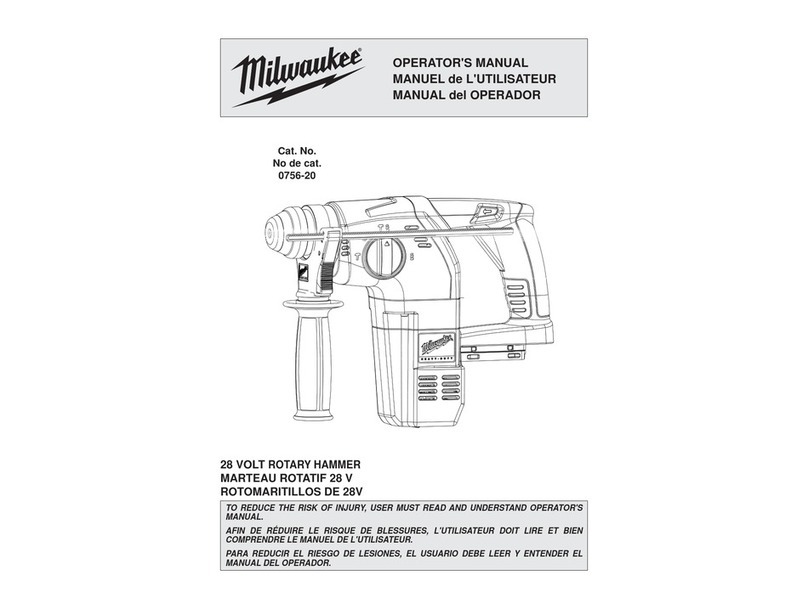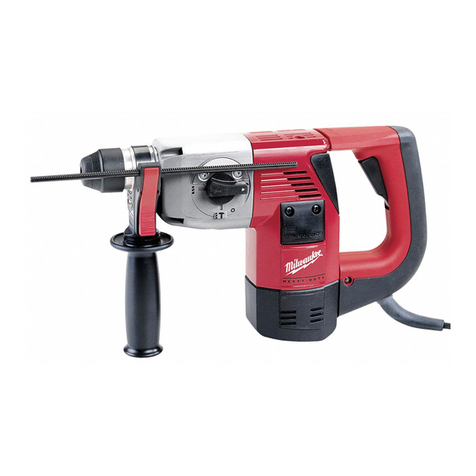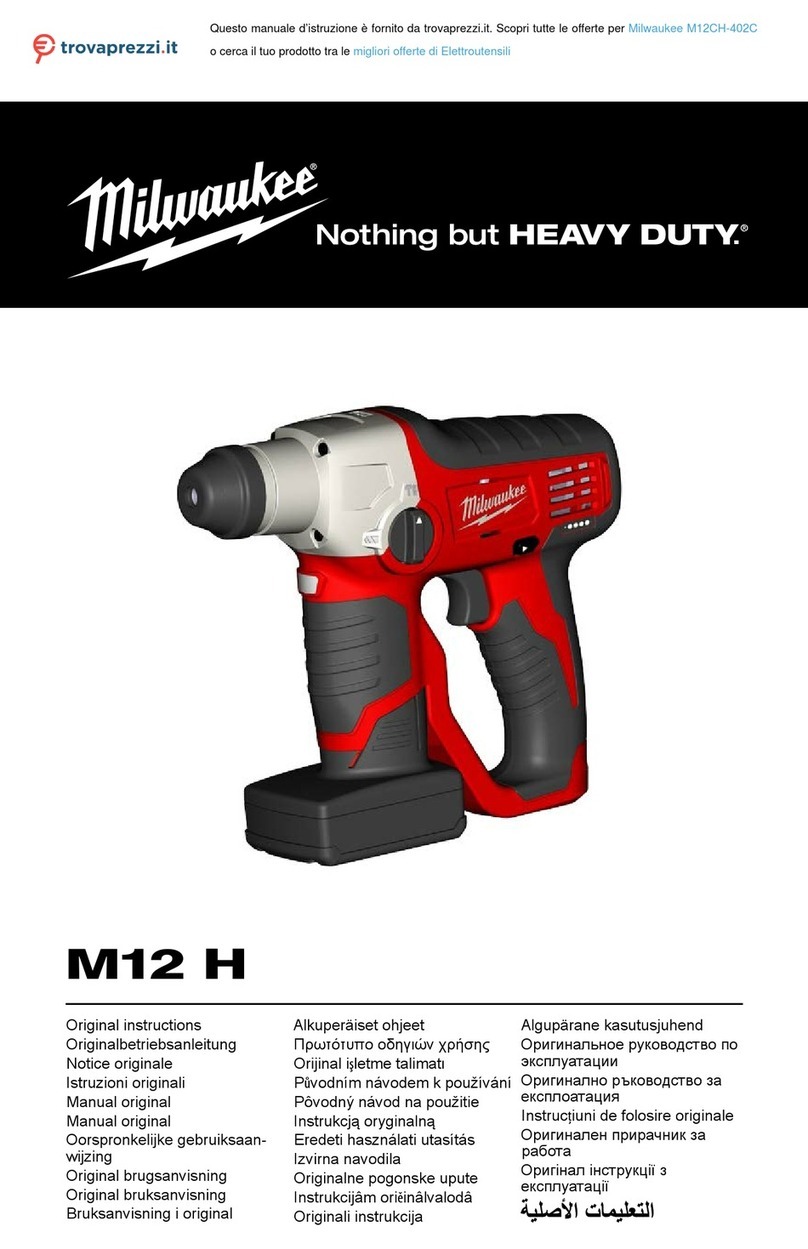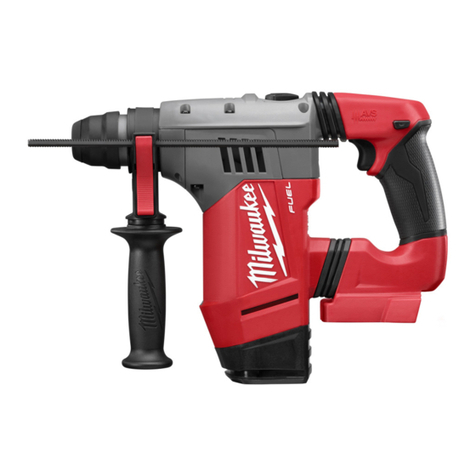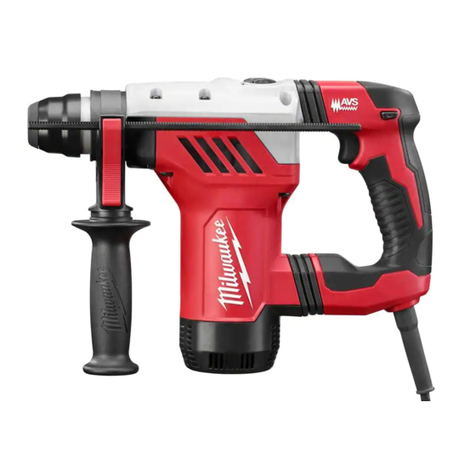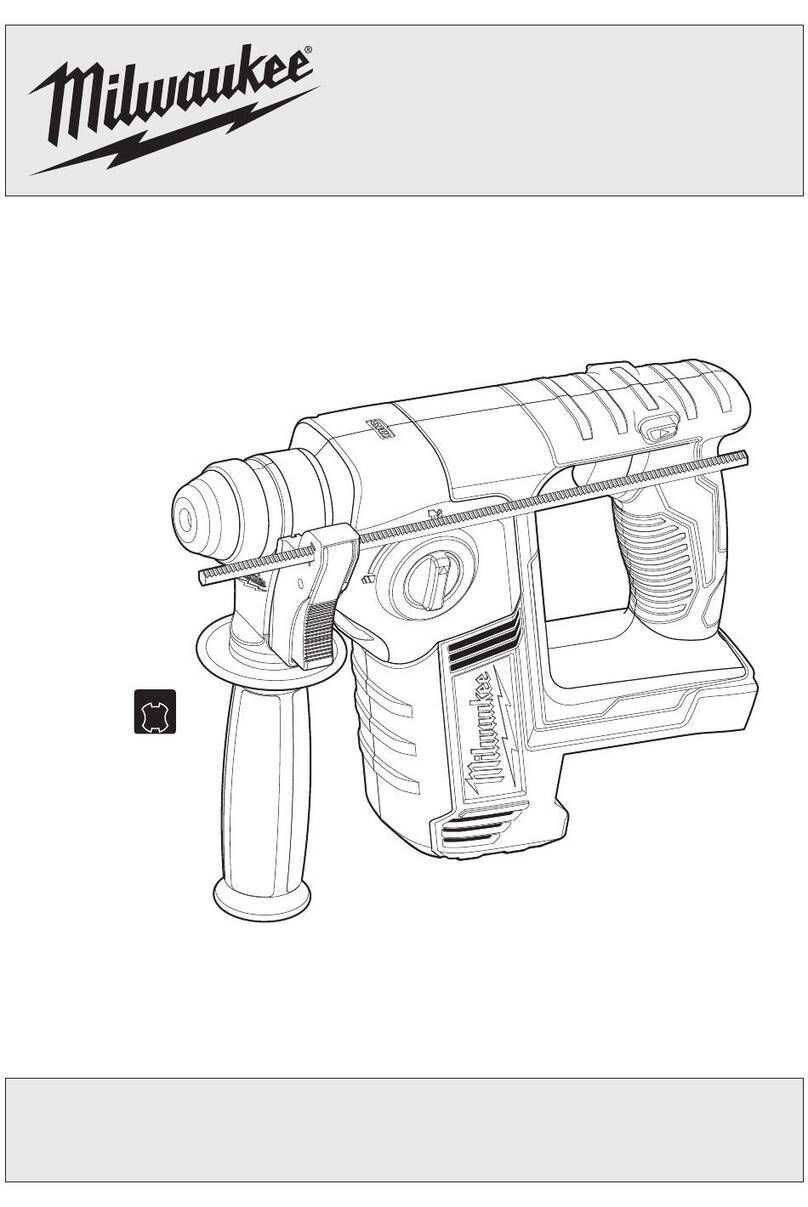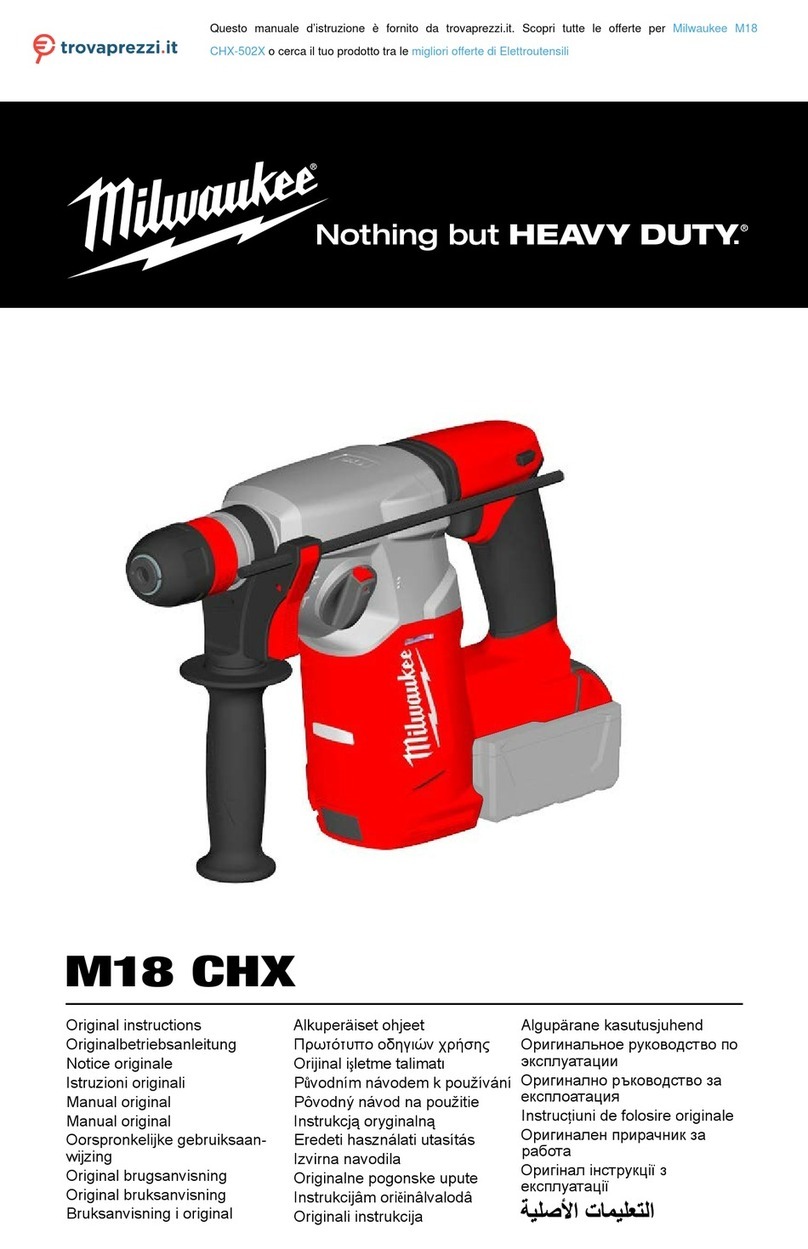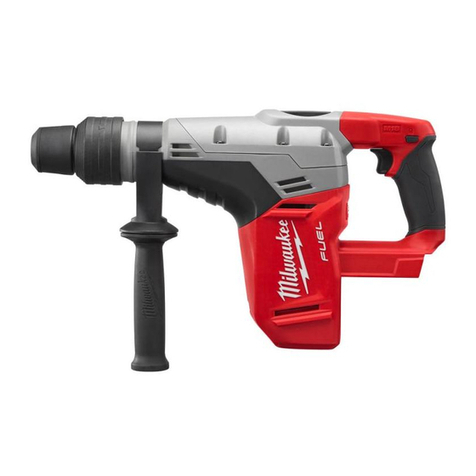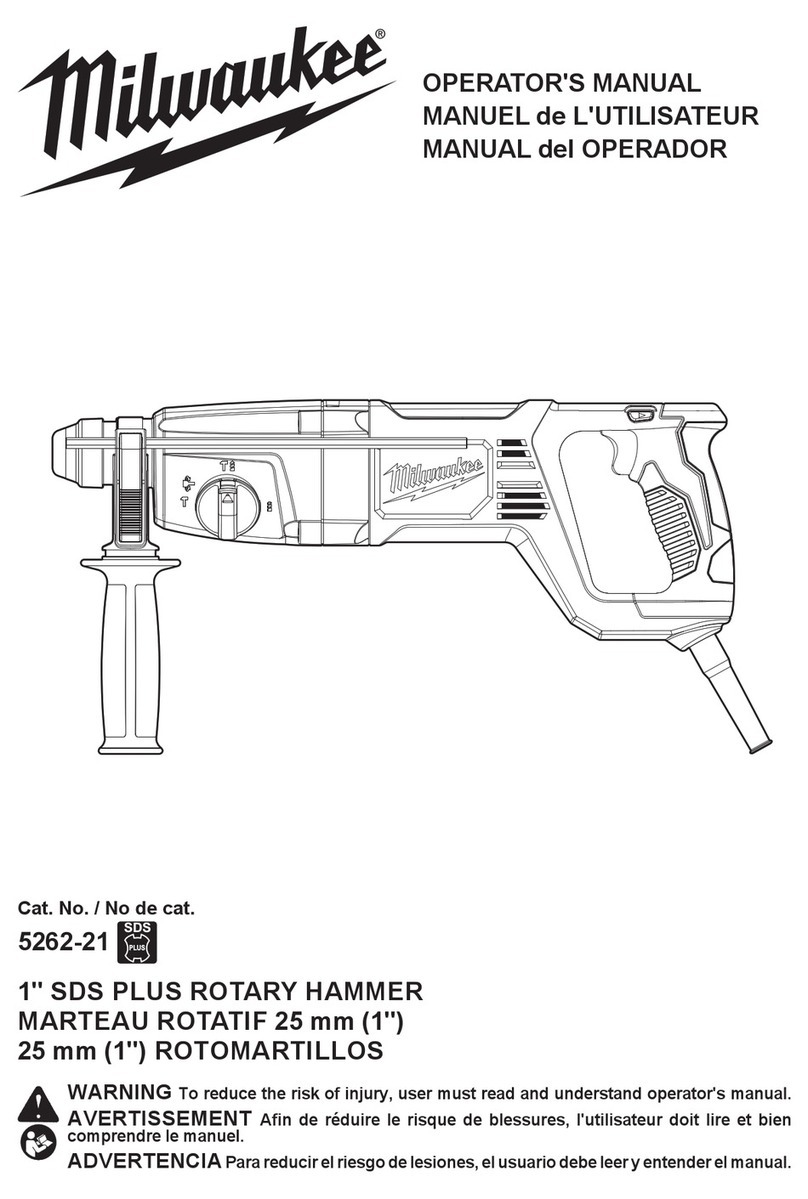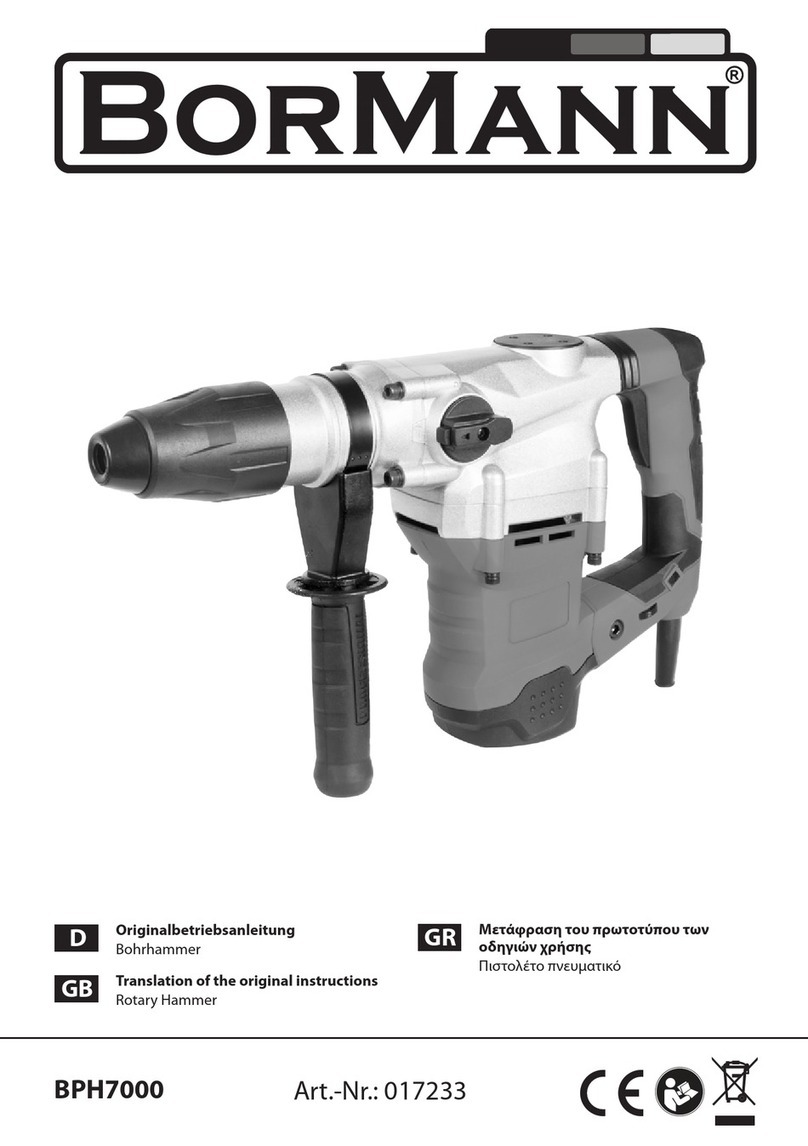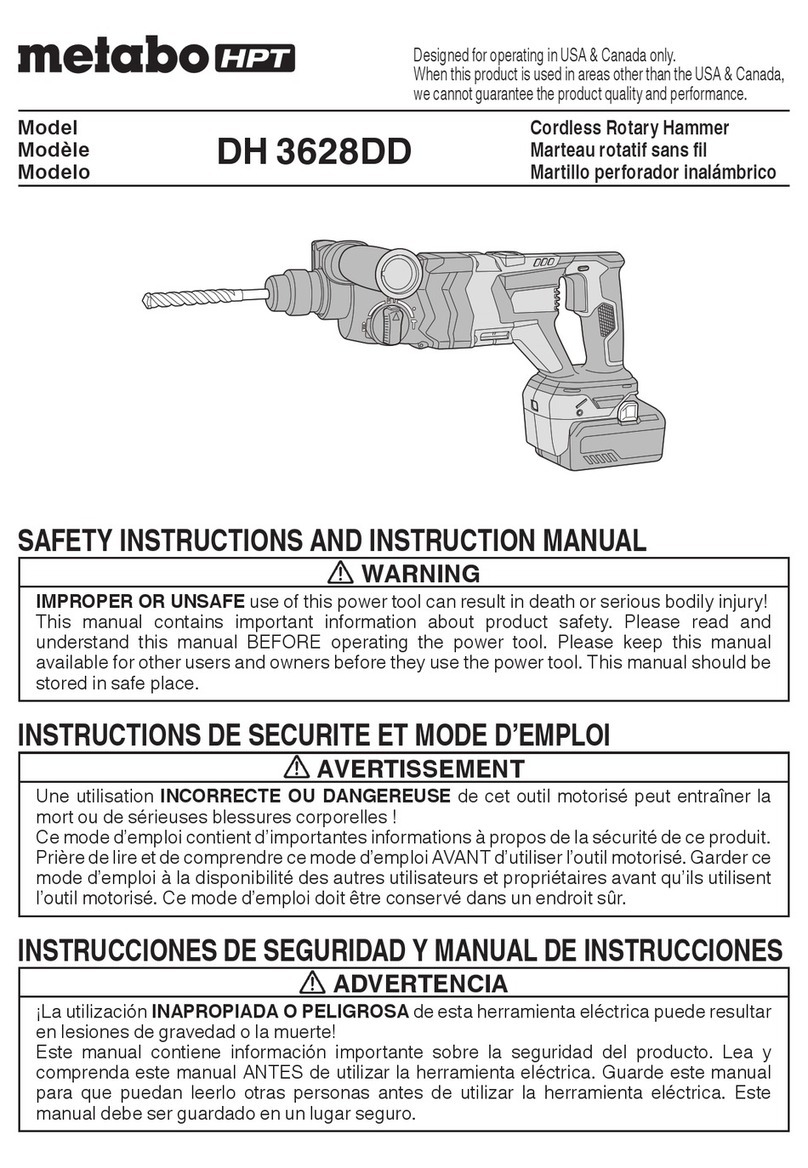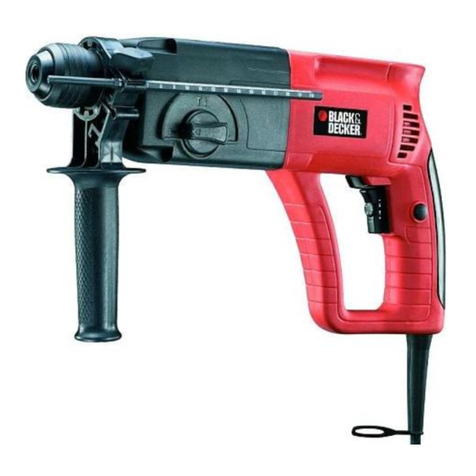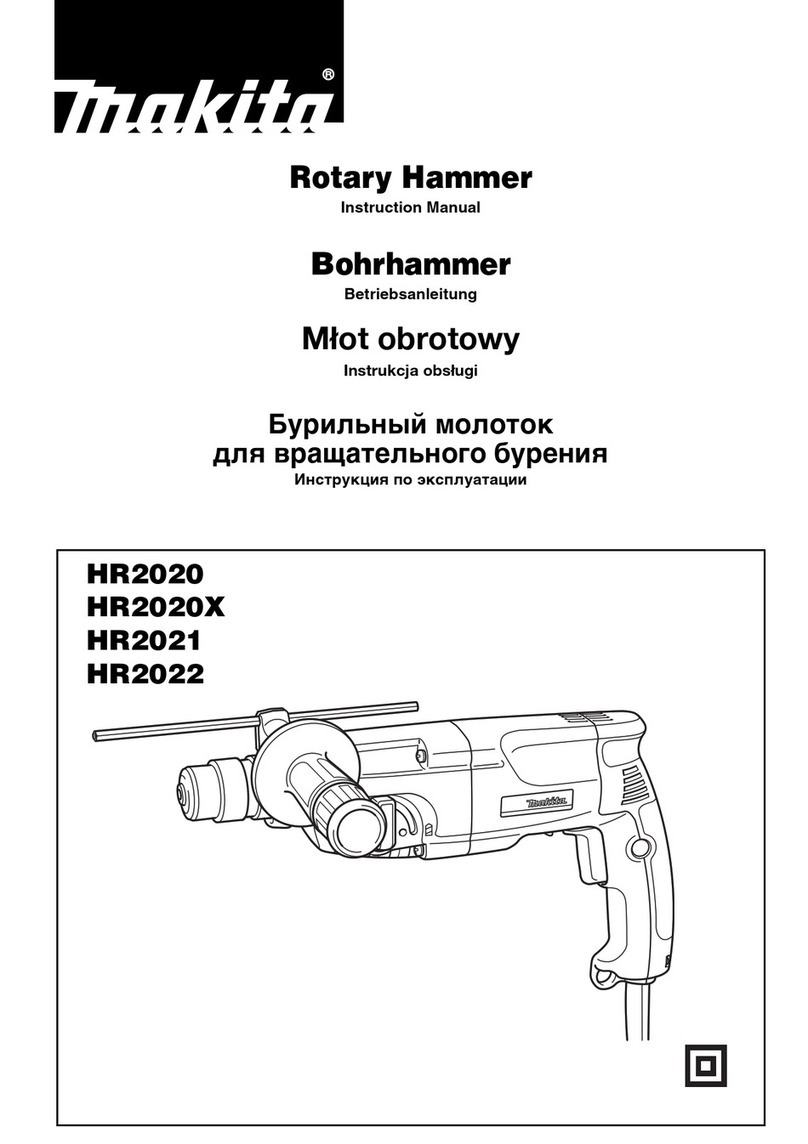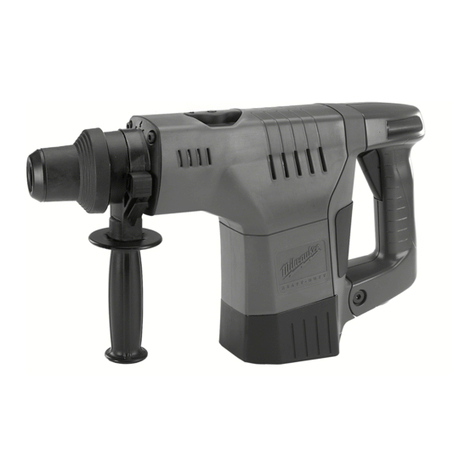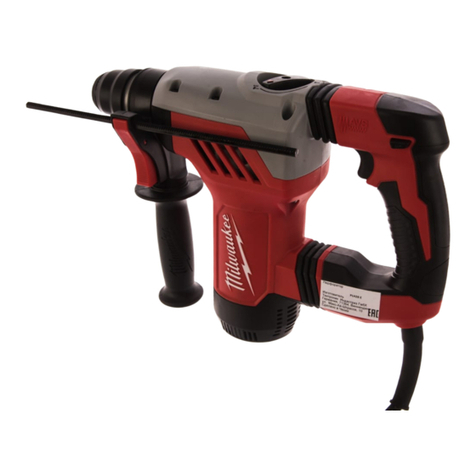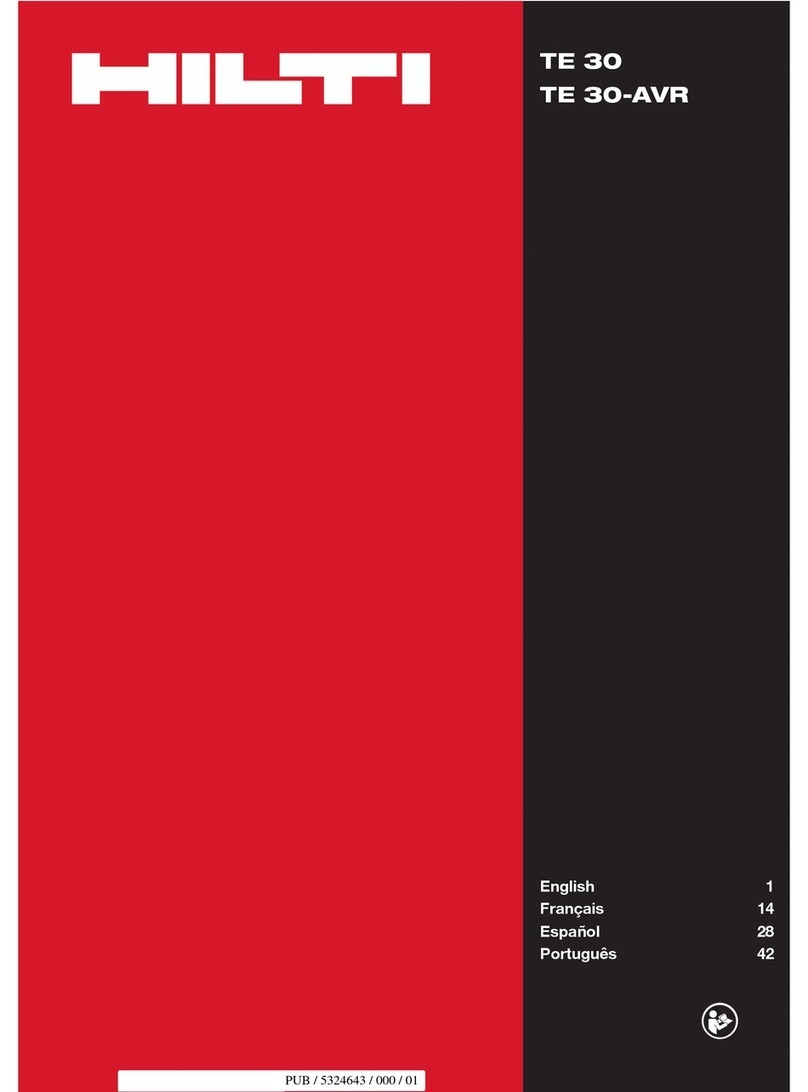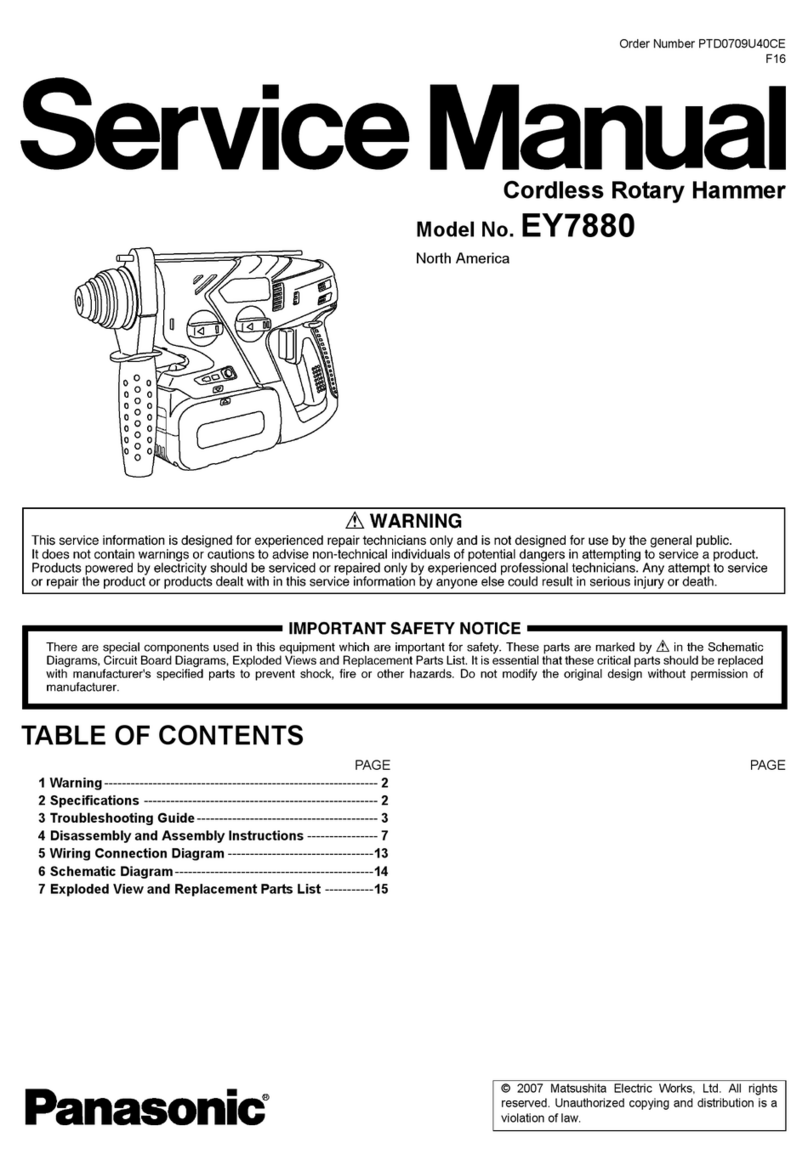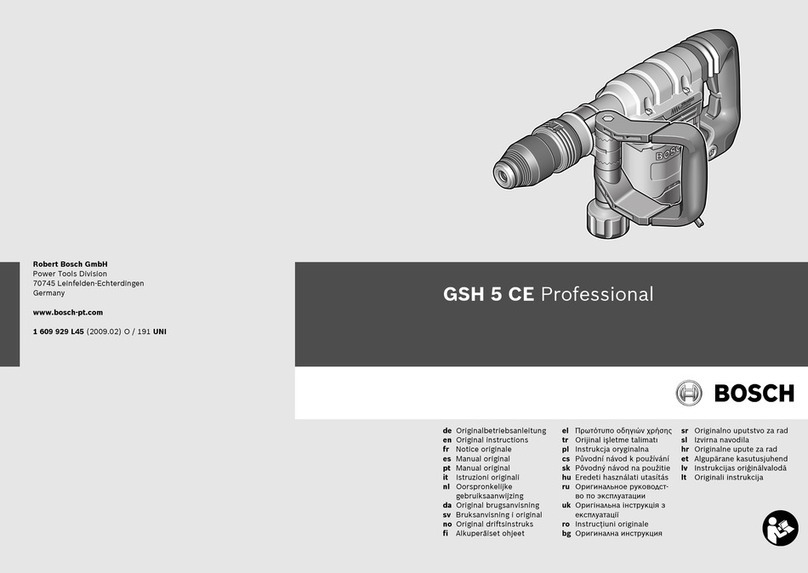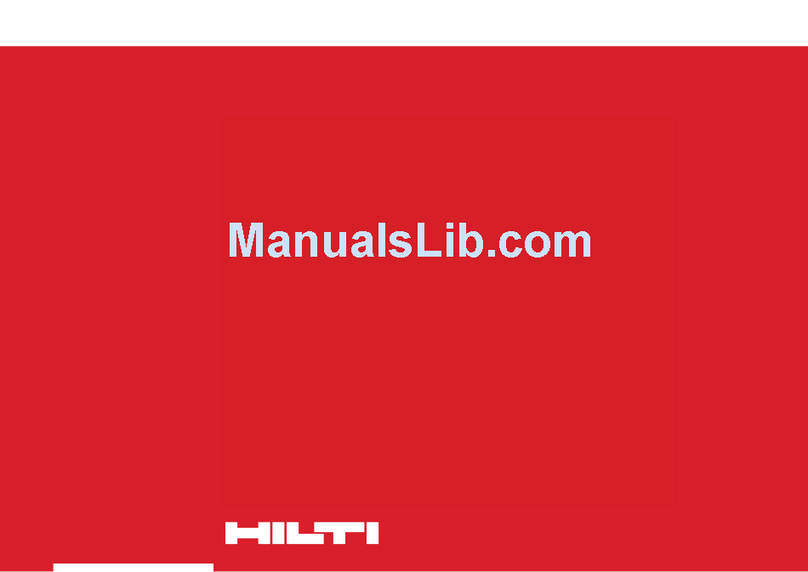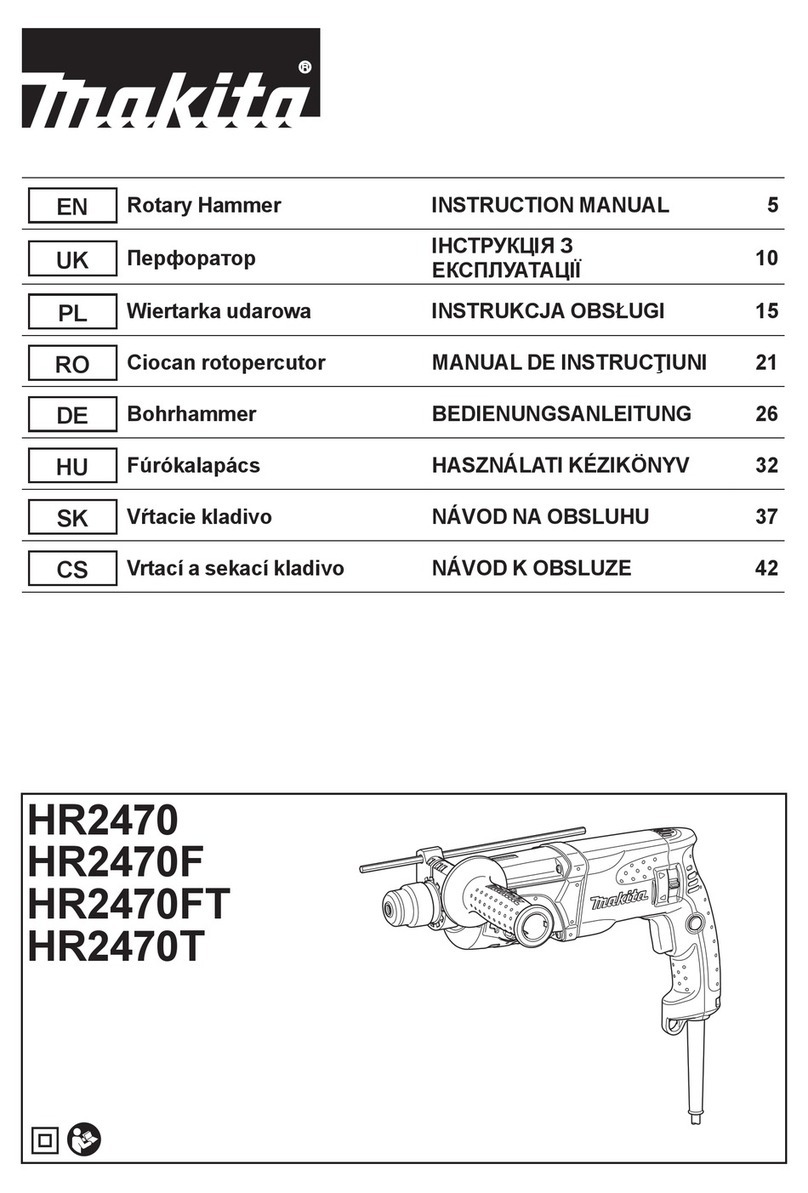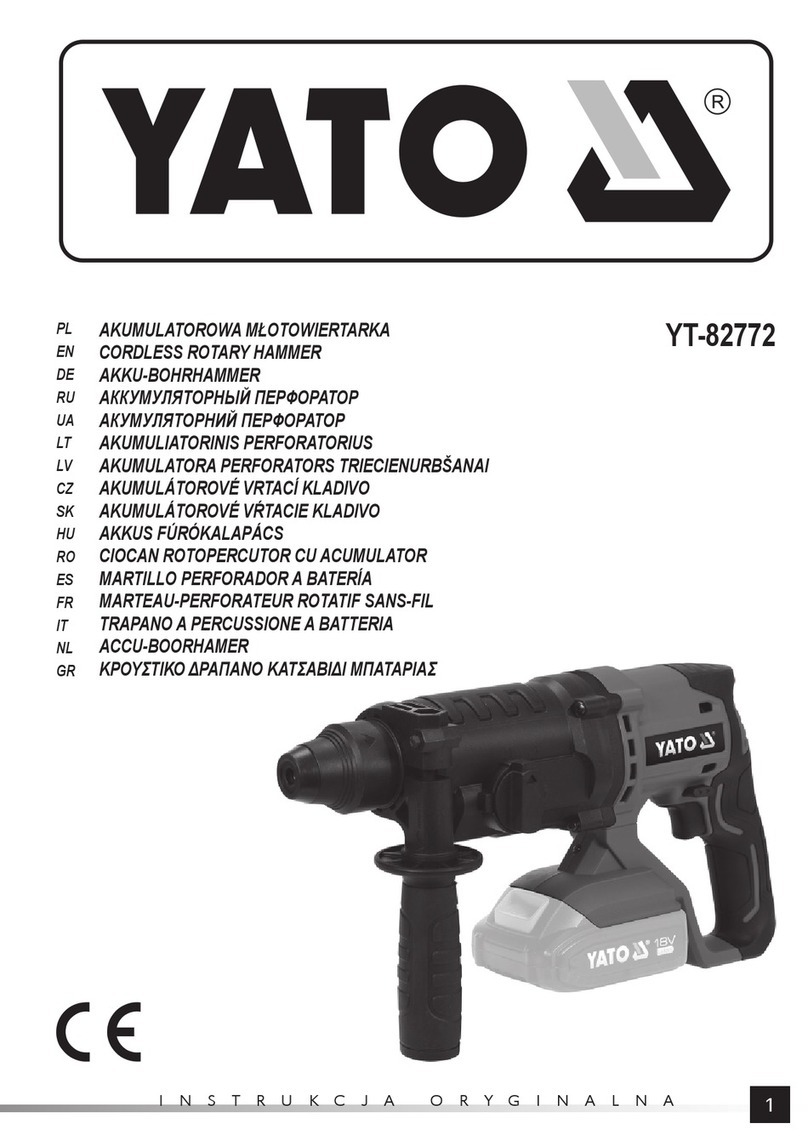
18 19
PLH 32 XE
4322 94 05 XXXXXX MJJJJ
900 W
450 W
3,8 J
0-1040
min
-1
0-800
min
-1
0-4500
min
-1
32 mm
16 mm
40 mm
82 mm
43 mm
3,6 kg
98 dB(A) / 3 dB(A)
106 dB(A) / 3 dB(A)
25 m/s2/ 2,3 m/s2
20 m/s2/ 1,5 m/s2
ENGLISH ENGLISH
TECHNICAL DATA
Type
Production code
Rated input
Output
Impact energy per stroke according to EPTA-Procedure 05/2009
No-load speed
Speed under load max.
Rate of percussion under load max.
Drilling capacity in concrete
Drilling capacity in steel
Drilling capacity in wood
Light core cutter in bricks and limestone
Chuck neck diameter
Weight according EPTA-Procedure 01/2014
Noise Information:
Measured values determined according to EN 62841.
Typically, the A-weighted noise levels of the tool are:
Sound pressure level / Uncertainty K
Sound power level / Uncertainty K
Wear ear protectors.
Vibration Information: Total vibration values (vector sum in the three
axes) determined according to EN 62841.
Vibration emission value ah/ Uncertainty K
Hammer-drilling in concrete:
Chiselling:
WARNING! Read all safety warnings, instructions,
illustrations and specifications provided with this power tool. Failure
to follow all instructions listed below may result in electric shock, fire and/
or serious injury.
Save all warnings and instructions for future reference.
HAMMER SAFETY WARNINGS
Safety instructions for all operations
Wear ear protectors. Exposure to noise can cause hearing loss.
Use auxiliary handles supplied with the tool. Loss of control can cause
personal injury.
Hold the power tool by insulated gripping surfaces only, when
performing an operation where the cutting accessory may contact
hidden wiring or its own cord. Cutting accessory contacting a "live" wire
may make exposed metal parts of the power tool "live" and could give the
operator an electric shock.
Safety instructions when using long drill bits with rotary hammer
Always start drilling at low speed and with the bit tip in contact
with the workpiece. At higher speeds, the bit is likely to bend if allowed
to rotate freely without contacting the workpiece, resulting the personal
injury.
Apply pressure only in direct line with the bit and do not apply
excessive pressure. Bits can bend causing breakage or loss of control,
resulting in personal injury.
ADDITIONAL SAFETY AND WORKING INSTRUCTIONS
Use personal protective equipment. Always wear eye protection.
Protective equipment such as a dust mask, non-skid safety shoes, hard
hat or hearing protection used for appropriate conditions will reduce
personal injuries.
The dust produced when using this tool may be harmful to health. Do not
inhale the dust. Wear a suitable dust protection mask.
Do not machine any materials that present a danger to health (e.g.
asbestos).
Switch the device oimmediately if the insertion tool stalls! Do not switch
the device on again while the insertion tool is stalled, as doing so could
trigger a sudden recoil with a high reactive force. Determine why the
insertion tool stalled and rectify this, paying heed to the safety instructions.
The possible causes may be:
• it is tilted in the workpiece to be machined
• it has pierced through the material to be machined
• the power tool is overloaded
Do not reach into the machine while it is running.
The insertion tool is sharp-edged and can become hot during use.
WARNING! Danger of cuts and burns
- when handling the insertion tools
- when setting the device down.
Wear protective gloves when handling insertion tools.
Chips and splinters must not be removed while the machine is running.
Keep mains lead clear from working range of the machine. Always lead
the cable away behind you.
When working in walls ceiling, or floor, take care to avoid electric cables
WARNING
The vibration and noise emission level given in this information sheet has been measured in accordance with a standardized test given in EN 62841 and
may be used to compare one tool with another. It may be used for a preliminary assessment of exposure.
The declared vibration emission level represents the main applications of the tool. However if the tool is used for dierent applications, with dierent
accessories or poorly maintained, the vibration emission may dier. This may significantly increase the exposure level over the total working period.
An estimation of the level of exposure to vibration should also take into account the times when the tool is switched oor when it is running but not
actually doing the job. This may significantly reduce the exposure level over the total working period.
Identify additional safety measures to protect the operator from the eects of vibration and/or noise such as: maintain the tool and the accessories, keep
the hands warm, organization of work patterns.
and gas or waterpipes.
Clamp your workpiece with a clamping device. Unclamped workpieces
can cause severe injury and damage.
Always disconnect the plug from the socket before carrying out any work
on the machine.
When working with large drill diameters, the auxiliary handle must be
fastened in a right angle with the main handle (see illustrations, section
"Twisting the handle").
SPECIFIED CONDITIONS OF USE
The rotary pneumatic hammer can be used for hammer drilling, chiselling in
stone and concrete and drilling in wood, metal as well as plastic.
Do not use this product in any other way as stated for normal use.
RESIDUAL RISK
Even when the product is used as prescribed, it is still impossible to
completely eliminate certain residual risk factors. The following hazards
may arise in use and the operator should pay special attention to avoid
the following:
• Injury caused by vibration.
Hold the product by designated handles and restrict working time and
exposure.
• Exposure to noise can cause hearing injury.
Wear ear protection and limit exposure.
• Injury due to flying debris
Wear eye protection, heavy long trousers and substancial footwear at
all times.
• Inhalation of toxic dusts.
MAINS CONNECTION
Appliances used at many dierent locations including wet room and open
air must be connected via a residual current device (FI, RCD, PRCD) of
30mA or less.
Connect only to single-phase AC current and only to the system voltage
indicated on the rating plate. It is also possible to connect to sockets
without an earthing contact as the design conforms to safety class II.
Make sure the machine is switched obefore plugging in.
This is a device for professional use which may slightly exceed the guide
values for current harmonics when it is connected to the public low voltage
mains supply. You should therefore contact your energy supply company
before you connect the device to the public low voltage mains supply.
WORKING INSTRUCTIONS
Do not force too much when drilling or hammering. Let the rotary hammer
do the work for you.
WORK WHEN IT'S COLD
If the tool is stored for a long period of time or at cold temperatures, the
lubrication may become stiand the tool may not working initially or the
working may be weak. If this happens:
1. Insert a bit or chisel into the tool.
2. Run the tool against a scrap piece of concrete.
3. Pull and release the trigger every few seconds.
After 15 seconds to 2 minutes, the tool will start hammering normally. The
colder the tool is, the longer it will take to warm up.
CLEANING
The ventilation slots of the machine must be kept clear at all times.
MAINTENANCE
Important note! If the carbon brushes are worn, in addition to exchanging
the brushes the tool should be sent to after-sales service. This will ensure
long service life and top performance.
If the supply cord of this appliance is damaged, it must only be replaced
by a repair shop appointed by the manufacturer, to avoid hazardous
situations.
Use only Milwaukee accessories and Milwaukee spare parts. Should
components need to be replaced which have not been described, please
contact one of our Milwaukee service agents (see our list of guarantee/
service addresses).
If needed, an exploded view of the tool can be ordered. Please state the
machine type printed as well as the six-digit No. on the label and order the
drawing at your local service agents or directly at: Techtronic Industries
GmbH, Max-Eyth-Straße 10, 71364 Winnenden, Germany.
SYMBOLS
Please read the instructions carefully before starting
the machine.
CAUTION! WARNING! DANGER!
Always disconnect the plug from the socket before
carrying out any work on the machine.
Always wear goggles when using the machine.
Wear ear protectors!
Wear a suitable dust protection mask.
Wear gloves!
The anti-vibration system reduces machine vibrations on
the handle.
Accessory - Not included in standard equipment,
available as an accessory.
Do not dispose of waste electrical and electronic
equipment as unsorted municipal waste.
Waste electrical and electronic equipment must be
collected separately.
Waste light sources have to be removed from
equipment. Check with your local authority or retailer for
recycling advice and collection point.
According to local regulations retailers may have an
obligation to take back waste electrical and electronic
equipment free of charge.
Your contribution to re-use and recycling of waste
electrical and electronic equipment helps to reduce the
demand of raw materials.
Waste electrical and electronic equipment contain
valuable, recyclable materials, which can adversely
impact the environment and the human health, if not
disposed of in an environmentally compatible manner.
Delete personal data from waste equipment, if any.
Rotary Hammer
